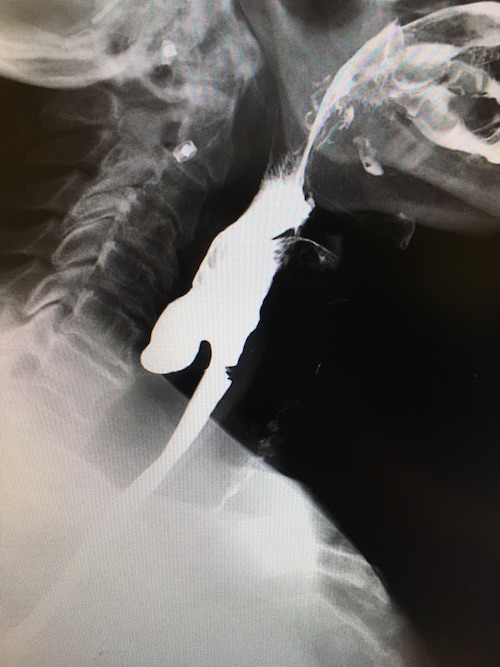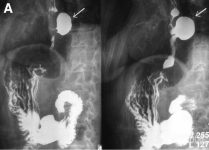Esophagus: Diverticula
Zenker Diverticulum
Description
- Location: Proximal Esophagus Through Killian’s Triangle
- False Diverticulum
- Does Not Involve All Layers – Only Mucosa & Submucosa
- Pulsion Diverticulum
- Caused by Increased Pressure from Failure of UES to Relax While Swallowing
- Diverticulum Form at Points of Weakness
- Most Have Associated Hiatal Hernia or GERD
- The Most Common Esophageal Diverticulum
Symptoms
- Dysphagia (Most Common – 80-90%)
- Regurgitate Non-Digested Foods
- Halitosis
- Hoarseness
- Cough
- *Symptoms Worsen Throughout the Day as Diverticulum Fills with Food
Diagnosis
- Dx: Barium Esophagram
Treatment
- Treatment:
- ASx & < 1 cm: Conservative Management
- Sx or ≥ 1 cm: Repair
- Open Surgery
- Cricopharyngeal Myotomy & Diverticulum Repair
- Through a Left Cervical Incision
- Diverticulum Repair:
- Small (< 2-3 cm): Diverticulopexy
- Fixation to the Prevertebral Fascia
- Moderate (3-5 cm): Diverticulopexy vs Diverticulectomy
- Large (> 5 cm): Diverticulectomy
- Small (< 2-3 cm): Diverticulopexy
- Cricopharyngeal Myotomy & Diverticulum Repair
- Endoscopic Diverticulotomy
- Endoscopic Division of Septum (Including Cricopharyngeal Muscle)
- Rigid Endoscopy Requires Neck Extension Although Newer Flexible Endoscopy Does Not
- Previously Required At Least 2-3 cm Length Although Newer Techniques Permit Treatment of Smaller Lengths
- Lower Complication Rates but Higher Recurrence Rate

Zenker Diverticulum
Traction Diverticulum
Description
- Location: Mid-Esophagus
- Usually Lateral/Peribranchial
- True Diverticulum (Involves All Layers)
- From Pulling at the Esophageal Wall by Scarring, Inflammation or Masses
- Causes: Inflammation, Tuberculosis, Histoplasmosis Lymphadenopathy, Tumor
Symptoms
- Largely ASx Until Large > 5 cm
- Dysphagia
- Postural Regurgitation
- Retrosternal or Epigastric Pain
- Heartburn
- Cough
Diagnosis
- Dx: Barium Esophagram
- Consider Manometry & Upper Endoscopy
- Possibly CT to Evaluate Paraesophageal Anatomy
Treatment
- Treat Underlying Pathology
- ASx: Conservative Management
- Sx: Diverticulectomy
- VATS Approach Preferred
- Myotomy Not Required

Traction Diverticulum 1
Epiphrenic Diverticulum
Description
- Location: Distal Esophagus (≤ 10 cm of GE Junction)
- Most Common on Right Posterolateral Wall
- Can Be Multiple & Located at Different Levels
- Diverticulum Can Be Either True or False
- Pulsion Diverticulum
- Caused by Increased Pressure from a Motility Disorder
- Diverticulum Form at Points of Weakness
- Most Have Associated Hiatal Hernia or GERD
- Incidence of Cancer 0.6% – Higher Risk with Delayed Diagnosis
Symptoms
- Largely ASx Until Large > 5 cm
- Dysphagia (Most Common)
- Postural Regurgitation
- Retrosternal or Epigastric Pain
- Halitosis
- Heartburn
- Cough/Aspiration
- Weight Loss
Diagnosis
- Dx: Barium Esophagram
- Consider Manometry & Upper Endoscopy
Treatment
- ASx: Conservative Management
- Sx: Diverticulectomy & Esophageal Myotomy
- Preform Myotomy on Opposite Side to Treat Underlying Motility Disorder
- Approaches:
- Laparoscopy (Typically Preferred) – Consider Concurrent Fundoplication
- Thoracotomy/VATS

Epiphrenic Diverticulum 2
References
- Guirguis S, Azeez S, Amer S. Sarcoidosis Causing Mid-Esophageal Traction Diverticulum. ACG Case Rep J. 2016 Dec 7;3(4):e175. (License: CC BY-NC-ND-4.0)
- Silecchia G, Casella G, Recchia CL, Bianchi E, Lomartire N. Laparoscopic transhiatal treatment of large epiphrenic esophageal diverticulum. JSLS. 2008 Jan-Mar;12(1):104-8. (License: CC BY-NC-ND-3.0)